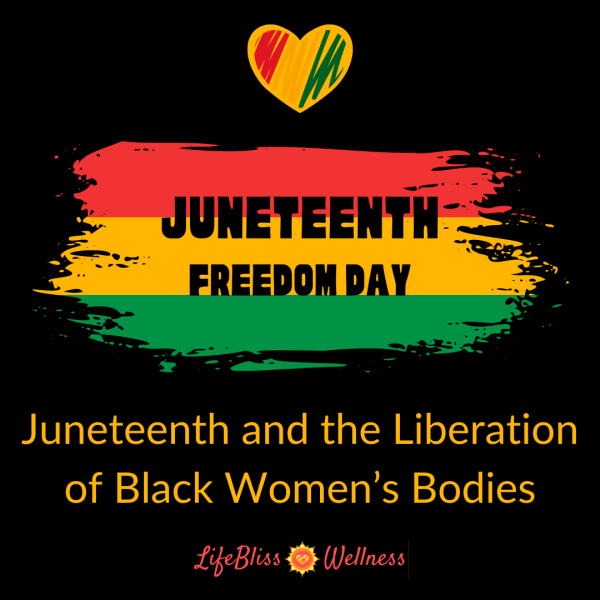Black women have been enduring racial and gender oppression since the first kidnappings and abuse as human chattel, dehumanization to keep the practice going, exclusion from social and economic progress and general disapproval to maintain a patriarchal hierarchy. Today, black women are arguably the least free group of humans in the US. We have been vulnerable, unprotected, controlled, policed, erased and disrespected throughout history. And yet, in the words of the late Maya Angelou, we “still rise”. We can’t be stopped, but we struggle.
Juneteenth is an appropriate opportunity for us as black women to take a moment to embrace our journey, honor our African roots, and create Black Joy as a form of resistance against current forms of oppression we may be facing, such as diet culture. Our ancestors found various ways to use their bodies as containers for pleasure and enjoyment and elevate their spiritual and political power to resist oppression. Today, we have the ability to unite and build a powerful force to continue our legacy of resilience into the future.
What is Juneteenth?

Juneteenth is Freedom Day for African Americans, also called Jubilee and Black Independence Day. It is celebrated on June 19th, in commemoration of this date in 1865 when Union soldiers rode into Galveston Texas with an order to end chattel slavery. The Emancipation Proclamation, which had been passed two and a half years earlier, was unenforceable in formerly Confederate states.
Juneteenth was declared a federal holiday by President Joe Biden in 2021, but it has been celebrated in Texas and other places since 1866. The occasion was marked by cookouts, barbeques, parades, marches, and family gatherings.
Juneteenth celebrations are often centered on rich food traditions. Red foods and dishes that represent good fortune are the cuisine of the day. Red juice or soda, hibiscus tea, watermelon, berries and red velvet cake are common treats. Just as blackeyed peas and greens are included in New Year’s Day prosperity meals, they are also popular Juneteenth dishes. Grilled meats, sweet potatoes, corn and cornbread are also holiday staples.
According to culinary historians, the color red has important meaning to the occasion. Red represents the sacrifice and bloodshed of the enslaved people, and also has West African spiritual and philosophical value as it symbolizes sacrifice, transition and power.
“The practice of eating red foods—red cake, barbecue, punch and fruit—may owe its existence to the enslaved Yoruba and Kongo brought to Texas in the 19th century,” from present-day Nigeria, Ghana, Togo, Benin, and the Democratic Republic of Congo, writes culinary historian and food writer Michael Twitty in his blog, Afroculinaria.
A Brief History of Misogynoir
Where did all the negative views and stereotypes of black women come from? Why do beliefs that we are unworthy, unlovable, inferior, unattractive, unfeeling and only valued as workhorses exist? Actually, it’s all a carefully orchestrated scam designed to create and maintain a social and economic hierarchy.
In the 18th century there was a whole movement to manufacture scientific proof of European superiority. (Previously, during the Renaissance judging differences in European and African women’s physical bodies was not a thing). But in the 18th century, it became an obsession. Portraying Africans as gluttonous and overindulgent and relating fatness and negativity to blackness in the European imagination was gaining traction.
White philosophers, physicians and religious leaders created new ways of judging beauty with particular emphasis on the female body. This inspired fear of the immorality of sensuality and pleasure and the abuses of food and drink.
Puritanical preoccupation with small bodies representing morality fell primarily on women.
“For although heavy men were being entrusted with the tools of reform, such as exercise and Christian temperance, fat women were commonly ridiculed for their intemperance and unattractiveness”.
~Sabrina Strings, Fearing the Black Body
The beauty standards were set up as patriarchal norms and not only sought to negatively portray black women, but to control women in general.
“English women of good standing were slimming down. Many had incorporated diet and weight related ideals of decency into their own self understandings. They had started taking the amount of fat on a woman’s body as indicative of her cultivation or lack thereof.”
~Sabrina Strings, Fearing the Black Body
This mindset of thinness as goodness was the foundation of diet culture. Diet culture as a useful, racist sexist tool of patriarchy to convince us that pleasure is sinful and unhealthy remains prevalent to this day.
Taking a step back, you would definitely wonder how black women are even still here. I don’t want to rehash all of the past and present atrocities committed against us because we all know and are traumatized by them. We are uniquely resilient. And this is what makes us the most amazing group of women in the world. We need to be reminded of this sometimes when we are in the throes of everyday challenges.
Black Joy as Resilience Through the Ages
During the slavery days, black people, but black women in particular, had ways of reclaiming their time and reclaiming their humanity which was routinely stolen from them.
Enslaved people essentially had at least 3 bodies:
“The first was the objective body that was acted upon by slaveholders. Early constructions of African and black women’s bodies and sexuality played a central role in justifying the African slave trade and gave license to sexual violence against black women. Colonial and antebellum slaveowners believed that strict control of the black body, in particular its movement in space and time, was key to their enslavement of black people. By the late antebellum years planters were working energetically to master such black bodily minutiae as nourishment, ingestion of alcohol, and even dress, all as part of their paternalist management strategies”.
~Stephanie M. H. Camp, The Pleasures of Resistance: Enslaved Women and Body Politics in the Plantation South, 1830-186, The Journal of Southern History
The second body was the subjective experience of being under extreme control, terror and suffering. This was the colonized body, subject to sale, violence, disease and exploitative labor.
The third body was the reclaimed body, the site of pleasure, pride and self-expression. This body was a political body in opposition to the slaveholders’ economic and punitive priorities. The third body is the body that some bonded people chose as a tool of rebellion. Enslaved people were prohibited from wandering far from their quarters in the evenings and so they would go through great lengths and risk to sneak off into the night to a designated spot for clandestine festivities that lasted sometimes until almost the morning light.
The illegal parties were planned ahead of time and people from different plantations would make their way a few miles away to some abandoned building or a secluded open space to party. The women managed to sneak and cook food for the event and took great pride in dressing themselves to impress. Sometimes they would dye the drab clothing that they were issued into magnificent colors. Or for the people who lived near ports, they would often negotiate with other enslaved people to get a hold of some fancy fabrics to sew dresses. They also came up with ingenious ways to do their hair for the occasions.
The men brought instruments for music making, and often would compete against one another in various things.
“In the context of enslavement, such exhilarating pleasure gotten by illicit use of the body must be understood as important and meaningful enjoyment, as personal expression and as oppositional engagement of the body”.
~Stephanie M. H. Camp, The Pleasures of Resistance: Enslaved Women and Body Politics in the Plantation South, 1830-186, The Journal of Southern History
Similarly,
“The history of Carnival brings to mind the singular characteristic that connects us with the past – freedom. Carnival was a celebration observed by the French plantocracy, as they bade farewell to the flesh with masquerade parties before the Catholic observance of Lent. But enslaved people, who were prohibited from participating, also celebrated Carnival with drumology and dance. They mocked the plantation owners in dress as they paraded through their villages. They also covered themselves in oil and molasses to depict the darker side of the Carnival”.
~Destination Trinidad and Tobago
The Experience of Pleasure as Healing and Strength
Today, black women are under immense pressure to conform to white beauty standards. Even though black women have often recognized our own beauty standards for ourselves, that don’t idolize extreme thinness, the whole concept of standardized beauty is still oppressive. Going to great lengths to alter bodies creates myriad potential health dangers. From eating disorders to botched plastic surgery, to compromised mental health, the risks abound, regardless of who created the impossible standards.
Diet culture and the standardization of beauty provides justification for rejection and exclusion, particularly in the workforce. When it has to do with our natural hair, there is constant scrutiny of our beauty and professionalism, and this has carried over into our own communities. One critical aspect of diet culture is that it doesn’t need authorities to enforce its standards. Eventually, peers will take on the policing duties. This makes oppression quite efficient. Black women making other black women feel less than should not be a thing, but unfortunately, the indoctrination runs deep.
So, Black Joy is not a hedonistic endeavor, it’s a means of survival. By owning our own narratives, we interrupt the power that any person or institution can wield over us. True happiness feeds our spirit in a way that has a lasting effect of blocking pain and negative vibes.
“At the heart of the Black Joy movement is what many scholars, journalists, authors, and others are describing as resistance, resilience, and reclamation of Black Humanity. Life brings everyone challenges, disappointments, losses, and unexpected difficulties, regardless of race. But when race is added to the mix, the situation is compounded exponentially. When people live in a world that devalues them because they are black or brown as well as dismisses their contributions to the larger society, Black Joy is and has been an effective tool that has allowed individuals and groups to shift the impact of negative narratives and events in their favor.”
~Elaine Nichols, Smithsonian National Museum of African American History and Culture
Oppressors gonna oppress, they don’t change their ways, they only change their methods. We have to liberate ourselves. We must stop begging for acceptance and live unapologetically. So let June 19th begin a new beginning of laughing, resting, de-stressing, making space for ongoing leisure and personal spirituality and living your absolute best life possible. Give yourself a little Juneteenth gift, of the first day of abandonment of diet culture with the enjoyment of traditional cuisines and a day of play. Allow this taste of freedom to inspire you to take meaningful actions towards allowing yourself to experience simple pleasures every single day to enrich your spirit and free your mind and soul.


 I’m LifeBliss Lisa, Happiness Lifestyle Coach
I’m LifeBliss Lisa, Happiness Lifestyle Coach